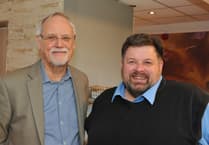Business News columnist James Penn of Thomas Miller Investment in the Isle of Man probes the possibility of interest rates increasing soon.
This column has dealt with the subject of interest rates several times in the past two years.
On the whole, this hasn’t been the most interesting subject, and there has been a perennial risk of boring one’s readers by dwelling on it too much.
There is always a danger of over-focusing on matters where nothing much changes, or is likely to change.
Once again, however, it is worth raising the question – are we at an important juncture?
Three big decisions - from the European Central Bank, the Bank of England, and the US Federal Reserve - have been looming.
Last week the ECB gave us their answer.
The Bank flagged earlier in the year that it would announce a tapering of its bond buying programme in October.
This it duly did, but was clearly conscious (bearing in mind what happened during the ‘taper tantrum’ in the US in 2013) that overegging this could unnerve markets.
The Federal Reserve was buying $85bn of assets per month at the time, roughly comparable to what the ECB has been buying (€80bn, cut to €60bn in March this year), so there must be a similar danger that a partial withdrawal from the market could ‘spook’ investors, and cause a similar sell-off.
In the event, Mario Draghi softened the blow a little. The ECB’s asset purchases will continue at the rate of €60bn until the end of the year, but will now drop to €30bn in January next year.
They will remain at that rate until at least September 2018, but Mr Draghi indicated they could continue beyond then if circumstances dictate.
In any event, the ECB will continue to ‘reinvest’ the proceeds of maturing bonds and interest.
He also indicated that there will be no change in interest rates ‘well past’ the ending of any QE programme – expectations are for no change on this front until 2019 at least.
The step down from €60bn to €30bn was described as a ‘downsize’. Any concerns that the ECB will ‘run out of assets to buy’ were scotched by assertions that it will just buy more corporate debt instead of government debt.
The Germans were notably silent on the matter. But they may get their chance later. Draghi is due to retire in 2019, and the most likely candidate to succeed him is Jens Weidmann.
They way the economy, stock market, and employment are going, it may be appropriate to make some changes on that front by then. Eurozone inflation – currently at 1.5 per cent - is still below the 2 per cent target, but is well clear of the deflationary zone.
So after Round 1, it was 1-0 to the doves.
For Round 2, we move to the UK, and the Bank of England’s next decision on interest rates.
The QE programme here finished earlier this year. This too appears to have been successful: stocks are up, employment up, GDP up (albeit the growth rate has declined to 1.5). But inflation is well up (last read on CPI, 3 per cent).
Without wishing to rehearse all the pros and cons of a rate hike again, the evidence – and the betting – over the last two months suggests a rise is likely.
The probability of a rise on November 2 has now moved to 85 per cent, after UK GDP growth came in a bit stronger than expected at 0.4 percent for Q3.
On the dovish side, in the past two weeks we have had the two deputy governors, Jon Cunliffe and David Ramsden, both suggesting that it was still an ‘open question’ whether rates should rise.
Retail sales are weak, service sector PMI has fallen, and the productivity figures remain dire. There is also a rather worrying political background.
On the hawkish side, this would just be taking out the August 2016 cut, and won’t be the start of an interest rate cycle.
Also the Governor, Mark Carney, seems to be in favour and will likely carry members with him.
For Round 3, we move to the US for the Fed’s meeting on December 12-13.
Here too, the probability of a rise (the third this year) has risen to 85 per cent.
The economy is doing pretty well after its Q1 soft patch, the stock market is at all times highs, housing starts are strong, consumer confidence high.
So here’s my forecast for the Q4 boxing match on interest rates: a technical victory (2-1 on points, or rounds) to the hawks.
The opinions stated are those of the author and should not be taken as investment advice. Any recommendations may not be suitable for all, so please contact your financial adviser for further guidance. The value of investments can go down as well as up.




